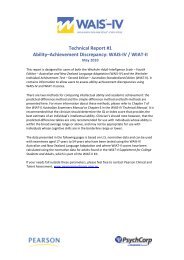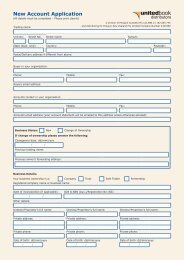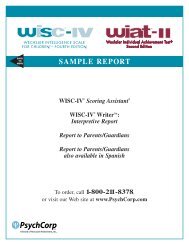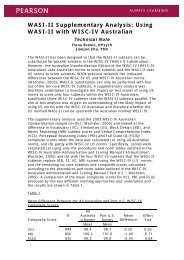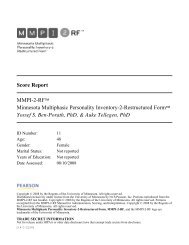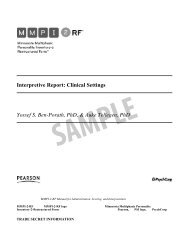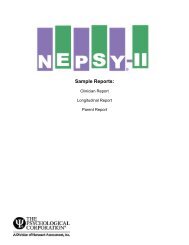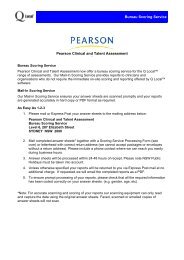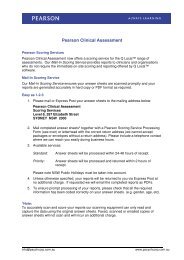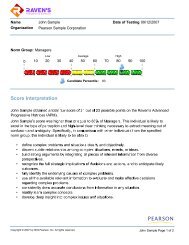WISC-IV with WIAT-II Writer Interpretive Sample Report - Pearson ...
WISC-IV with WIAT-II Writer Interpretive Sample Report - Pearson ...
WISC-IV with WIAT-II Writer Interpretive Sample Report - Pearson ...
You also want an ePaper? Increase the reach of your titles
YUMPU automatically turns print PDFs into web optimized ePapers that Google loves.
BACK<br />
TO<br />
MENU<br />
<strong>WISC</strong>-<strong>IV</strong> and <strong>WIAT</strong>-<strong>II</strong> <strong>Interpretive</strong> <strong>Report</strong><br />
Written Language<br />
In overall written language skills, Haley performed in the Low Average range, as indicated by<br />
her Written Language Composite standard score (82). Her achievement in this area is better<br />
than of only approximately 12% of students her age. Haley's performance on tasks that required<br />
her to generate words <strong>with</strong>in a category, generate sentences to describe visual cues, combine<br />
sentences, and compose an organized paragraph (Written Expression standard score = 78) is<br />
comparable to her performance on tasks that required her to correctly spell verbally presented<br />
words (Spelling standard score = 88).<br />
Strengths And Weaknesses<br />
Compared to Haley's mean score for all <strong>WIAT</strong>-<strong>II</strong> subtests, her performance is significantly better<br />
in Numerical Operations, indicating that this is an area of relative strength for her. Compared to<br />
those of other children her age, however, her skills in this area are in the Average range.<br />
Word Reading and Pseudoword Decoding are notable weaknesses for Haley. Her scores on<br />
these subtests are significantly less than her mean score for all <strong>WIAT</strong>-<strong>II</strong> subtests, indicating that<br />
these are areas of lower performance relative to her other skills. She performed better than only<br />
approximately 3% and 5% of her peers on Word Reading and Pseudoword Decoding,<br />
respectively. Thus, Haley may experience great difficulty keeping up <strong>with</strong> other students when<br />
these skills are needed.<br />
Ability-Achievement Discrepancy Analysis Predicted Method<br />
Haley's scores on the <strong>WIAT</strong>-<strong>II</strong> were compared to the levels of achievement predicted for a<br />
student <strong>with</strong> her general cognitive ability, as indicated by her Verbal Comprehension score of<br />
112 on the <strong>WISC</strong>-<strong>IV</strong> administered 6/12/2003. Significant differences between actual and<br />
predicted achievement scores are reported in this section.<br />
Haley displays difficulty <strong>with</strong> achievement in reading. She scored much lower on the Reading<br />
Composite (actual score = 75) than expected for a child <strong>with</strong> her general cognitive ability<br />
(predicted score = 109). The difference between her actual and predicted scores is significant and<br />
highly unusual. Thus, this is an area in which Haley may benefit from assistance in helping her<br />
further develop her skills. Word Reading (actual standard score = 72), Pseudoword Decoding<br />
(actual standard score = 75) and Reading Comprehension (actual standard score = 83) are areas<br />
of difficulty for Haley. The difference between Haley's actual and predicted scores on the Word<br />
Reading subtest (37 points) is both significant and highly unusual, and indicates a specific<br />
weakness in tasks that required her to correctly read a series of printed words. For the<br />
Pseudoword Decoding and Reading Comprehension subtests, the discrepancy between her actual<br />
and predicted scores(32 points) and(26 points) is also significant, suggesting a specific weakness<br />
in tasks that required Haley to correctly apply phonetic decoding rules when reading a series of<br />
nonsense words and read sentences and paragraphs and answer questions about what was read.<br />
Specifically, there is a noteworthy difference between her Math Reasoning subtest score (91) and<br />
the level of achievement anticipated for a student <strong>with</strong> her cognitive ability (predicted score =<br />
108). This significant and highly unusual difference indicates performance lower than expected<br />
Copyright © 2003 by Harcourt Assessment, Inc.<br />
All rights reserved. Printed in the United States of America.<br />
Page 4



